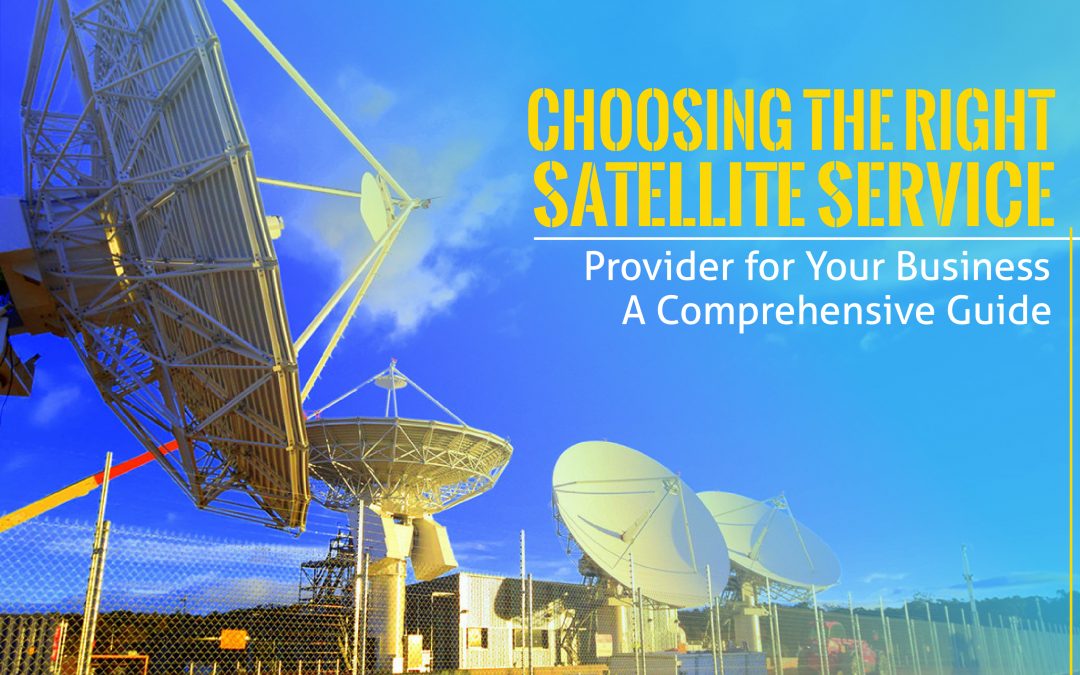In today’s interconnected world, businesses increasingly rely on satellite services for communication, data transfer, and internet connectivity. Whether you’re in a remote location, running a maritime operation, or managing a large-scale enterprise with diverse needs, choosing the right satellite service provider is crucial. This comprehensive guide will walk you through the key factors to consider when selecting a satellite service provider for your business.
1. Assess Your Business Needs
Coverage Area
Determine the geographical areas your business operations cover. Ensure the satellite provider offers robust coverage in these regions. Some providers specialize in certain areas, so aligning their coverage with your operational regions is essential. For instance:
- United States: Providers like HughesNet and Viasat offer extensive coverage nationwide, including rural and remote areas.
- United Kingdom: Inmarsat and SES Networks provide reliable services throughout the UK and its territories.
- Australia: Providers such as Optus Satellite and NBN Co cater to both urban and outback regions.
- Canada: Telesat and Xplornet offer extensive coverage, including remote northern areas.
- Dubai: Yahsat and Thuraya provide comprehensive coverage in the Middle East and beyond.
Bandwidth Requirements
Evaluate your data needs. Consider the volume of data your business transmits and receives daily. Different providers offer various bandwidth plans, so selecting one that can handle your data load without compromising performance is vital.
Type of Services Satellite services
Identify the specific services you need. Satellite providers offer various services, including internet connectivity, voice communication, and data transfer. Ensure the provider can deliver the required services efficiently.
2. Evaluate Technology and Infrastructure
Satellite Types
Understand the different satellite types available:
- Geostationary Satellites (GEO): Offer broad coverage with stable connections, ideal for fixed locations.
- Medium Earth Orbit Satellites (MEO): Provide lower latency and are suitable for dynamic environments like maritime operations.
- Low Earth Orbit Satellites (LEO): Ensure low latency and high-speed connectivity, perfect for real-time applications and mobile operations.
Ground Infrastructure
Check the provider’s ground infrastructure, including teleport facilities and Network Operations Centers (NOCs). Reliable infrastructure ensures consistent service quality and quick issue resolution.
3. Consider Service Reliability and Support
Uptime Guarantee
Look for providers with high uptime guarantees. Service reliability is crucial for business continuity, so a provider offering at least 99.9% uptime is preferable.
Customer Support
Evaluate the quality of customer support. 24/7 support is essential, especially for businesses operating in different time zones. Test their response time and the effectiveness of their support services.
4. Analyze Cost and Contract Flexibility
Pricing Models satellite services
Compare pricing models from different providers. Some offer flexible pay-as-you-go plans, while others provide fixed monthly or annual contracts. Choose a model that aligns with your budget and usage patterns.
Contract Terms
Review the contract terms carefully. Look for flexibility in scaling services up or down, early termination clauses, and any hidden fees. A provider with adaptable terms is beneficial as your business grows or changes.
5. Security and Compliance
Data Security
Ensure the provider has robust security measures in place. Data encryption, secure access controls, and regular security audits are critical features to look for.
Regulatory Compliance
Verify that the provider complies with relevant regulations and industry standards. This is particularly important if your business operates in highly regulated sectors like finance or healthcare.
6. Check for Additional Features
Redundancy and Backup
Providers offering redundancy and backup options can ensure continuous service during outages or maintenance periods. This is vital for mission-critical operations.
Integration Capabilities
Ensure the satellite service can integrate with your existing systems. Seamless integration reduces the complexity of managing multiple communication channels and improves efficiency.
The Role of Satellite Service Providers in Enabling Remote Business Operations
Satellite service providers play a critical role in enabling businesses to operate efficiently in remote and underserved areas. Here are some key ways they facilitate remote business operations:
Bridging the Connectivity Gap
- Remote Locations: Satellite communications provide connectivity in regions where traditional terrestrial networks are unavailable or unreliable. This is particularly beneficial for industries such as mining, oil and gas, agriculture, and maritime operations, which often operate in isolated areas.
- Disaster Recovery: In the aftermath of natural disasters, terrestrial communication infrastructure can be damaged or destroyed. Satellite service providers ensure continuous communication during recovery efforts, allowing businesses to coordinate and maintain operations.
Enhancing Operational Efficiency
- Real-Time Data Transfer: Remote operations require real-time data transfer for monitoring and decision-making. Satellite services enable real-time data transmission from remote sensors, vehicles, and equipment, facilitating better management and operational efficiency.
- Remote Workforce Connectivity: Satellite services enable remote teams to stay connected through reliable internet and communication services, allowing for seamless collaboration and coordination regardless of location.
Boosting Business Continuity with satellite services Communications
Maintaining business continuity is vital for any organization, and satellite communications are a key component in ensuring uninterrupted operations. Here’s how satellite service providers boost business continuity:
Ensuring Redundancy
- Backup Connectivity: Satellite networks can serve as a backup to terrestrial networks. In case of terrestrial network failures, businesses can switch to satellite connectivity, ensuring continuous operations without significant downtime.
- Diverse Routing: Satellite communications provide an alternative routing path for data, which is crucial for businesses that require highly reliable communication channels. This diversity in routing reduces the risk of complete network failure.
Supporting Critical Applications
- Emergency Communication: In critical situations, satellite communications provide reliable channels for emergency communications, ensuring that key personnel can communicate and coordinate effectively during crises.
- Secure Data Transmission: For industries handling sensitive information, satellite services offer secure and encrypted communication channels, ensuring that data remains protected even during outages or cyber-attacks.
Satellite Service Providers and the Future of IoT in Business
The Internet of Things (IoT) is transforming how businesses operate by enabling smart, connected devices to collect and exchange data. Satellite service providers are pivotal in expanding the reach and capabilities of IoT in business:
Expanding IoT Reach
- Global Coverage: Satellite networks provide global coverage, enabling IoT devices to operate in remote and underserved areas. This is essential for applications such as environmental monitoring, asset tracking, and agriculture.
- Real-Time Connectivity: Satellite services offer real-time connectivity for IoT devices, allowing businesses to monitor and manage operations from anywhere. This real-time data is crucial for making informed decisions and optimizing processes.
Enabling Advanced IoT Applications satellite services
- Remote Monitoring and Control: With satellite connectivity, businesses can remotely monitor and control IoT devices, leading to better resource management and operational efficiency. This is particularly beneficial for industries like agriculture, where remote sensors can monitor soil conditions and optimize irrigation.
- Enhanced Data Analytics: Satellite-enabled IoT devices collect vast amounts of data, which can be analyzed to gain insights into operations and drive innovation. For instance, in logistics, real-time tracking data can be used to optimize routes and improve delivery times.
Future Trends Satellite Service
- 5G and Satellite Integration: The integration of 5G and satellite technology will further enhance IoT capabilities, providing higher data speeds and lower latency. This will enable more advanced applications such as autonomous vehicles and smart cities.
- Increased Adoption of LEO Satellites: The rise of Low Earth Orbit (LEO) satellites is expected to revolutionize IoT connectivity by providing low-latency, high-speed internet access. This will make IoT solutions more feasible and cost-effective for businesses worldwide.
Few Satellite Service Providers
Based on reliability, coverage, and service quality, here are a few of the best satellite service providers across different regions:
- United States: HughesNet, Viasat
- United Kingdom: Inmarsat, SES Networks
- Australia: Optus Satellite, NBN Co
- Canada: Telesat, Xplornet
- Dubai and Middle East: Yahsat, Thuraya
- Global Providers: Iridium, Intelsat, Eutelsat
Conclusion
Choosing the right satellite service provider for your business involves a thorough evaluation of your needs, the provider’s capabilities, and the overall value offered. By considering factors such as coverage area, bandwidth requirements, service reliability, cost, security, and additional features, you can make an informed decision that supports your business operations effectively. Investing time in selecting the right provider will pay off in the long run, ensuring seamless communication and connectivity for your business












